

| |
| MAIN OH2BR QRGs NEWS REPORTS SPONSORS LOGS WHY PITCAIRN GUESTBOOK | www.qsl.net |

|
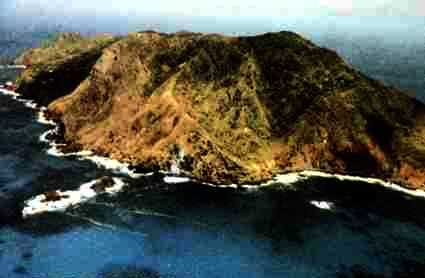
|
Pitcairn is a small volcanic island, with an area of 4,35 sq km with 4 km at the broadest, situated at 25'04"S and 130'06"W 2,170 km South East of Tahiti in French Polynesia, and 5,310 km North East of Auckland New Zealand. It has rugged volcanic formations with rocky coastline with cliffs. The climate is tropical, hot and humid, modified by Sotheast trade winds. Population in July 1999 was 49. Islanders have been Seventh-day Adventists since 1887. Pitcairn is British Dependent Territory administrated by The British High Commissioner located in Auckland, New Zealand. |
| Pitcairn Islands as seen from the air. |
| HISTORY OF PITCAIRN ISLAND |
Polynesians may have settled Pitcairn as long as 3500 years ago, at least temporarily, and archaeologists believe there was a Polynesian settlement on the island between the 12th and 15th centuries AD. At that time, a lively trade was carried on between Pitcairn,
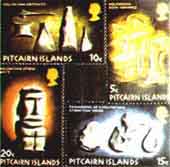
| |
| Many of Pitcairn Islands stamps are related to distant history of the island. |
Pitcairn was first discovered in 1767 by Philip Carteret who sailed by on HMS Swallow. Carteret did not land on the island due to the difficult landing conditions. He named it Pitcairn's Island after the young man who first spotted the island, son of major Pitcairn from the royal marines. Carteret miscalculated the latitude for his discovery (he failed by 300 km), and no one except Captain Cook showed any interest in his report. This was probably one of the reasons why Christian Fletcher later had chosen the island as the destination for captured HMS Bounty.
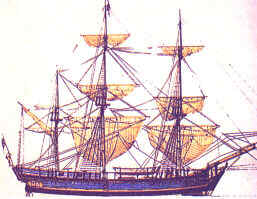
| |
| HMS Bounty. |
Few years later in 1787 HMS Bounty sailed from England to collect cuttings from breadfruit trees to take to the West Indies. It was believed (wrongly, as it later turned out) that the breadfruit would make an ideal and cheap food for slaves working the British plantations there. The Bounty stayed in Tahitian waters for five months, waiting for breadfruit to grow. During this time many sailors involved in local activities, and many of them lived with Tahitian women, and some were even expecting children. Most of the men were not happy to leave the island. With Fletcher Christian as their leader the sailors captured the ship from Captain Bligh three weeks after they left Tahiti with breadfruit plants onboard. Bligh and his 18 loyal crewmen were left in a small longboat in the open ocean, while Bounty sailed back to Tahiti. Bligh and his crew miraculously made it to Kupang on Dutch East Timor.
In January 15th 1790 the mutineers arrived at Pitcairn after four month of search for a hideaway far from British naval justice. Led by Christian, the party included eight other mutineers, six Tahitian men, 12 Tahitian women and a child. A few days later the mutineers burned their bridges in Bounty Bay as the good ship Bounty went up in smoke. Despite good intentions to peacefully co-exist, within a couple of years the new Pitcairners started to a kill each other. By 1794 all the Polynesian men and five of the mutineers, including Christian, were dead. Young, Adams, Quintal and McCoy were still alive but their attitude towards each other was still tense.
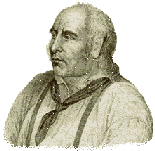
| |
| John Adams, the only survival from the HMS Bounty. |
A few peaceful years followed before McCoy discovered how to produce a spirit from the roots of the local ti plant. In 1796, and driven under the influence, he threw himself into the sea with a rock tied around his neck. A few years later Quintal's wife fell to her death while searching for birds' eggs, and shortly after Quintal became so crazed under the drink's influence that Adams and Young defended themselves against him with an axe, killing him. Young died natural death of asthma in 1800, leaving John Adams as the sole male adult survivor. Before his death Young managed to teach Adams how to read, who took the remaining 10 women and 23 children under his wing. Adams became a patron of the island. He found interest in the religion, and started educating Pitcairners using the only remaining book - the bible.
Adamstown was a small peaceful settlement of God-fearing Christians when Captain Mayhew Folger of the American sealer Topaz rediscovered Pitcairn, solving the 19 years old mystery of what had happened to the Bounty after the mutiny. Folger, on his trip back home informed the British. Britain was preoccupied with Napoleonic War at that time, and it was not before 1814 that the first British ship HMS Tagus arrived on Pitcairn.
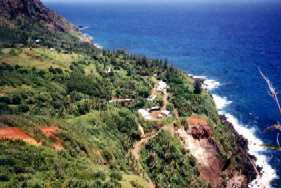
| |
| Adamstown today. |
By the time John Adams was dead in 1829 the population had reached 86, of which 79 were born on the island. In 1831 the British government concerned with Pitcairns overpopulation, relocated the islanders to Tahiti, where they were welcomed, but within months ten of the Pitcairners had died of unfamiliar diseases. By the end of the year the 65 survivors were all back on Pitcairn. The island became a British colony in 1838 but the old overpopulation fears rised again with the rising birth rate. In 1856 the entire population of 194 was moved to Norfolk Island, an uninhabited former Australian prison island east off Australia's coast. Two years later, 16 home sick islanders returned to Pitcairn, just in time to prevent the French annexing it to their Polynesian colony. Other families returned in 1864. Still today there are strong ties between people of Pitcairn and Norfolk Islands.
Pitcairn's population grew to its peak of 223 just before World War II. Recently depopulation rather than overpopulation has become a major concern, as islanders leave for better opportunities in New Zealand or elsewhere. In 1956 the population was 161, in 1961 126, in 1966 96, and in 1976 74. Through the 80s and 90s the figure has generally been in the 40s and 50s. Many of the houses are empty or falling down, and lack of opportunities may finally force the population below a viable level. Accessibility has been a big part of the problem. For years after the settlement's discovery sealing ships and passenger ships on the Panama-New Zealand passenger ship route paid regular visits, but modern air travel has reduced island contacts to visiting yachts, cargo ships that can be persuaded to stop and the occasional cruise ship.
| PITCAIRN TODAY |
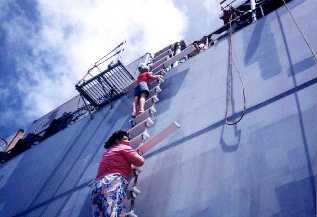
| |
| Climbing Jacobs ladder. Visiting ships are substantial for Pitcairn existence. |
In the beginning of the year 2000 the Pitcairners are the busiest making their carvings and other things that they take out to the tour ships for sale. After the first day of the year 2000 there will be several ships that will be stopping at Pitcairn for a day or part of one. Some will have quite a few passengers aboard so they hope to make lots of sales. One of the ships to come by is the Russian ship Akademik Shuleikin. Captain of the ship stopped in a year or so ago, and really enjoyed it, and decided to make it one of his yearly stops.
Not all ships want to slow down or stop at Pitcairn. Sometimes the ships just drop off the mail in a barrel without slowing down and the Pitcairners have to catch the barrel out to get the mail.
There is a French vessel there now with some scientists aboard, who are checking the sea mounts around the area. They are working along with a submarine. Maybe OH2BR could get the submarine to take him to Ducie!
The twin hull Polynesian canoe that people are rowing in the South Seas came to visit Pitcairn in August 1999. They had an escort vessel with them. Tom went out to the canoe but said he wouldn't like to be on it.
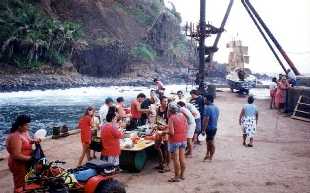
| |
| Celebrating Bounty Day January 23rd, Pitcairn National Day. The big model of the ship is being burned in the Bounty Bay like 210 years ago. |
The Governor's Deputy and the Commissioner for Pitcairn Islands, Mr. Leon Salt from Auckland, New Zealand, visited Pitcairn in October 1999 to look into the road project started.
The government is asking for an increase in the electric rates from 20c per kWh to 70 c per kWh, because of the increase of the island's use and increase of the cost of shipping the fuel for the generators. Many are talking about going to bottled gas for the cooking stoves. As we now know, the electric rate was increased to 50 c starting January 1st 2000. The government will not be paying any of the costs of shipping to the island. All costs are to be paid for by the islanders. It will cost 6,000 pounds sterling for the ship to stop at Pitcairn plus US$3,000 for each container that they bring. All of the islanders are ordering as much of supplies they can afford before the new charges apply January 1st.
According to the latest news from Tom, the supply ship will probably arrive at Pitcairn about December 28th. She is unable to bring all of the supplies that the people ordered. There are 10 bottled gas stoves and some T-shirts and a few other items that will probably go on the ship leaving Auckland January 19th.
For more info on the island please visit Pitcairn Island WEB Site.
| AMATEUR RADIO ON PITCAIRN |
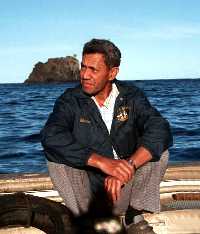
| |
| Tom Christian VP6TC, probably the best known Pitcainer. |
Tom and Betty Christian, VP6TC and VP6YL, are without any doubt the two best known Pitcairn HAMs. Tom was licenced in 1957 and Betty followed in 1984. They have four daughters: Darilene, Sherilene, Jacqueline VK2CD and Raelene ZL2RAE. All are currently living abroad. Tom and Betty keep regular skeds several times a week with their overseas radio friends. One of them is Howie WA6TUJ, who hosted the Christians for a few weeks in his home in Sacramento, CA. Their daughter Darlene spent several months at Howie in 1993. Howie has been essential in keeping touch with Tom during the preparation stage of the VP6BR DXpedition and relaying important information. Tom and Betty moved this year into their new house. Tom is currently building a radio shack up on the hill. There is no power limit in Pitcairn but Tom has not been using a linear for several years. He usually runs 70W on 15m into a 250 ft longwire antenna, and is able to talk to the US without any trouble. Sometimes Tom and Betty go up the hill to work their daughters in New Zealand and Australia using 40m band.
Irma Christian VP6ID sometimes runs the skeds for Tom and Betty if they are away on the longboat or too busy. She used to be a second assistant radio operator on the commercial radio station up Taro Ground. Her son Dennis has also received a HAM license with a callsign VP6DR.
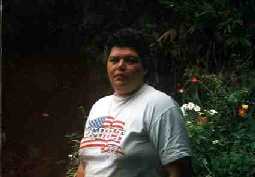
| |
| Meralda Warren VP6MW, Islands Policewoman. |
Brian Young VP6BX married Norwegian Kari Boye in 1977. She has been a professional radio officer on the ship before moving to Pitcairn, and she was very active some time ago with a callsign VR6KY. Kari has written a book on Pitcairn in Norwegian (Den siste mytterist). Kari, Brian and their two children are currently living in Auckland, New Zealand. Some years ago Brian spent a few days on Ducie making many IOTA hunters happy. In October he visited Pitcairn for a few weeks, and was also active on the HAM bands.
Dave Brown VP6DB earned his licence in 1994. Other active HAMs are Meralda Warren VP6MW, islands Policewoman, and Mike Warren VP6AZ.The following are novices needing CW upgrade: VP6TY Terry Young, brother of VP6BY currently living in New Zealand, VP6JC Jay Warren, VP6SC Shawn Christian, VP6LW Lorraine Warren and VP6PL Paul Warren.
Nelson ZL2FR spent a few years on Pitcairn during World War II, and a couple of his children were born there.
